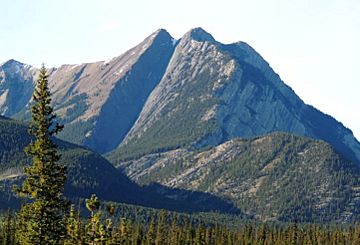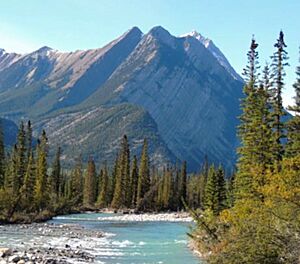Mount Ernest Ross facts for kids
Quick facts for kids Mount Ernest Ross |
|
|---|---|

Mount Ernest Ross
|
|
| Highest point | |
| Elevation | 2,454 m (8,051 ft) |
| Prominence | 99 m (325 ft) |
| Parent peak | Mount Hensley (2820 m) |
| Listing | Mountains of Alberta |
| Geography | |
| Location | Alberta, Canada |
| Parent range | Canadian Rockies |
| Topo map | NTS 83C/01 |
| Type of rock | Sedimentary |
Mount Ernest Ross is a mountain in the Canadian Rockies of Alberta, Canada. It stands tall at 2,454 meters (about 8,051 feet). This mountain has a unique feature called a double summit, which means it has two peaks close together.
You can see Mount Ernest Ross from the David Thompson Highway. It is also visible from the southern end of Abraham Lake. Water from the mountain flows east into this lake. Across the lake to the east is Mount William Booth. To the southeast, you'll find Kootenay Plains and Ex Coelis Mountain. The closest higher peak is Elliott Peak, which is about 3 kilometers (1.9 miles) to the north.
History of Mount Ernest Ross
This mountain is named after a man named Ernest Ross. In 1940, he was the first person to drive a motorized vehicle from Rocky Mountain House to Saskatchewan Crossing. This was many years before any proper road was built there.
Ernest Ross was very important in getting the David Thompson Highway built. When the highway was finished in 1969, he was honored for all his hard work. The mountain officially received its name, Mount Ernest Ross, in 1980. This name was approved by the Geographical Names Board of Canada.
How Mount Ernest Ross Was Formed
Mount Ernest Ross is made of sedimentary rock. This type of rock forms over a very long time from layers of sand, mud, and tiny bits of plants and animals. These layers were laid down during ancient periods, from the Precambrian era to the Jurassic period.
Later, during a time called the Laramide orogeny, huge forces pushed these rock layers. They were pushed east and even moved over younger rocks. This process helped create the tall mountains we see today in the Rockies.
Climate Around Mount Ernest Ross
The area around Mount Ernest Ross has a subarctic climate. This means it has very cold and snowy winters. The summers, however, are usually mild.
Temperatures can drop below -20 °C (which is -4 °F). When you add the wind chill factor, it can feel even colder, sometimes below -30 °C (-22 °F). Wind chill makes the air feel colder than the actual temperature because of the wind.




